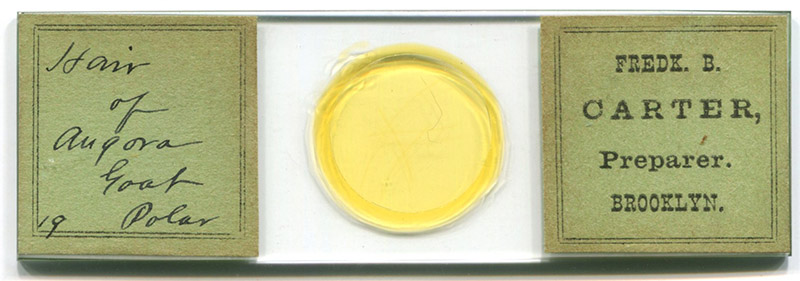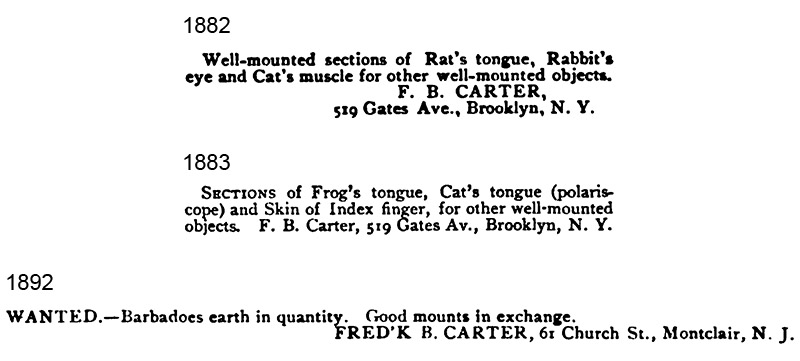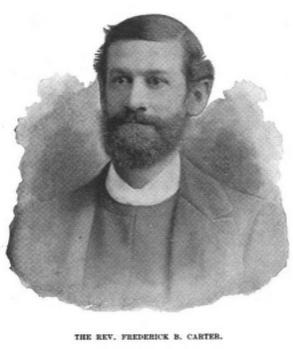
Figure 1. Figure 1. A microscope slide that was prepared by Frederick B. Carter, with his 1875 – 1884 address of Brooklyn, New York.
Frederick Brewerton Carter, 1850 - 1924
by Brian Stevenson
last updated July, 2021
Reverend F.B. Carter was an Episcopal minister in New York and New Jersey, USA, and an avid microscopist from ca. 1880 through the rest of his life. Carter produced quality microscope slides, with custom-printed labels, for his own collection and for exchange with other microscopists (Figures 1 and 2).

Figure 1.
Figure 1. A microscope slide that was prepared by Frederick B. Carter, with his 1875 – 1884 address of Brooklyn, New York.

Figure 1.
Figure 2. Exchange offers from F.B. Carter, all published in "The American Monthly Microscopical Journal". He moved from Brooklyn to Montclair in 1884, and lived in that latter town until the end of his life.

Figure 1.
Figure 3. Frederick B. Carter, as a relatively young man. Adapted for nonprofit, educational purposes from https://www.findagrave.com/memorial/167707795/frederick-brewerton-carter.
Frederick Brewerton Carter was born in Brooklyn on March 6, 1850, son William Henry and Elen Maria (née Knapp) Carter.
Carter trained for the ministry at the General Theological Seminary of the Protestant Episcopal Church, New York, and graduated in 1873. He then served as minister to the Christ Episcopal Church, in West Islip, Long Island. He moved to St. George's Episcopal Church, Brooklyn, in 1875. Frederick, his wife Frances ("Fanny"), and their five children enjoyed the benefits of domestic servants.
Frederick Carter advertised to exchange microscope slides of animal histological specimens in 1882 and 1883 (Figure 2). The slide shown in Figure 1, of angora goat hair, probably dates from around that time. During this period, Carter appears to have joined the Brooklyn Microscopical Society. That group became part of the Brooklyn Institute of Arts and Sciences in 1888, and Carter continued a corresponding member well into the twentieth century.
The Carters moved to Montclair, New Jersey, in December, 1884, with Frederick taking charge of St Luke's Episcopal Church.
In New Jersey, Carter joined the Essex County Microscopical Society. The group's records indicate that he made frequent presentations at meetings, and served as an officer.
Carter made numerous detailed investigations of microorganisms such as rhizopoda, desmids, diatoms, and radiolaria during the late 1880s and into the 1890s. He undoubtedly made numerous microscope slides of his subjects, but it is not known whether he prepared and labeled them as nicely as those he made for exchange while in Brooklyn (Figure 1). He wrote of making fluid mounts of desmids in phenol-water, a technique that probably would not have resulted in permanent mounts.
At the November 2, 1887 meeting of the Essex County Microscopical Society, "a paper on the Rhizopoda was read by Mr. Carter, who has studied these low forms of animal life during several years. The paper, which treated of the different species of Rhizopods, their classification, habits, external and internal structure, modes of reproduction, &c., was followed by a lantern exhibit; the slides used for this purpose being prepared by Mr. Carter".
Carter published "Desmids: their life history and their classification" in The Microscopical Journal in 1889. He began the two-part article, "Hardly any attention has been bestowed upon the desmids by the microscopists of this country, if we are to judge by the pages of the Microscopical Journal for the past seven years. There are but two or three articles which deal with this subject in all those volumes. Note the multitude of pages on the diatoms and be struck by the contrast. Microscopists seem almost to have gone diatom-mad. The amount that has been written on the resolution of fine lines and dots would alone fill a volume. Now, while the attempt to resolve the more difficult diatoms has been vastly beneficial to the makers of objectives, it has not proved of much solid benefit to the amateur. Had he spent a quarter of the time he has given to this task in the observation of any one of half a dozen interesting members of the animal or vegetable world, biologically and systematically considered, he would have gotten far more use out of his tube and been able to help others as well. These neglected desmids, for example, are equally worthy of study with the diatoms - far ahead of them in interest if the examination of the latter is confined to the resolution of delicate markings. The desmids are to be found everywhere, climate interposing no barrier to their distribution, from the north pole to the equator. Wolle says: 'They are nearly equal in number of species to that of all the other orders of fresh-water algae'. They occur in immense quantities. Last spring a good sized pond in Orange, N.J., was so coated with a single species of Closterium along the border that the mud beneath was almost concealed. The mind wearies as it tries to conceive of the billions upon billions of this single species in that one pond alone. They are of wonderful diversity, no other family in the whole range of the plant world presenting such a boundless variety of forms. They are strikingly beautiful in shape and color and markings".
Although he frowned on the obsession over diatoms as test objects, Carter was fascinated with the biology of the diatomaceae. In 1891, he published a four-part article on "Diatoms: their life-history and their classification" in The American Monthly Microscopical Journal.
He published the six-part "Radiolaria: their life-history and their classification" in 1892. At that same time, he advertised to exchange his "good mounts" for "Barbadoes earth in quantity". That material is rich in the mineral skeletons of radiolaria and other microscopical life, and may have been sought to aid Carter's studies. The "good mounts" may have been new productions, older slides from his Brooklyn days (see Figure 1), or even slides that Carter owned that had been produced by other makers.
In 1893, Carter published "Classification of the Radiolaria". The next year, he published "Classification of the Radiolaria: key to the species of Barbadoes" and "Radiolarian shale from Manitoba". He identified and named at least three new species of radiolaria in 1896.
Carter appears to have ceased publishing microscopy articles after that time, possibly due to increased demands of his work. He retired from the ministry in 1912, and was appointed Archdeacon of Newark. An obituary wrote that Carter, "for many years, especially since his retirement, was interested in microscopical work. For many years he was a member of the Microscopical Society of America".
Frederick B. Carter died at his home in Montclair on November 14, 1924.
Resources
The American Monthly Microscopical Journal (1882) Exchange offers from F.B. Carter, pages 160, 180, and 200
The American Monthly Microscopical Journal (1883) Exchange offer from F.B. Carter, page 20
The American Monthly Microscopical Journal (1887) Microscopical societies: Essex County, N.J., page 218
The American Monthly Microscopical Journal (1892) Exchange offer from F.B. Carter, page 80
Carter, Frederick B. (1889) Desmids: their life history and their classification, The Microscopical Journal, pages 35-38 and 73-79
Carter, Frederick B. (1891) Diatoms: their life history and their classification, The American Monthly Microscopical Journal, pages 1-6, 81-85, 97-102, and 121-123
Carter, Frederick B. (1892) Radiolaria: their life history and their classification, The American Monthly Microscopical Journal, pages 63-64, 111-113, 143-145, 177-180, 216-219, and 257-259
Carter, Frederick B. (1893-1894) Classification of the Radiolaria, The American Monthly Microscopical Journal, Vol. 14, pages 223-230, and 305-307, and Vol. 15, pages 112-121
Carter, Frederick B. (1894) Radiolarian shale from Manitoba, The American Monthly Microscopical Journal, pages 51-53
Carter, Frederick B. (1894) Classification of the Radiolaria: key to the species of Barbadoes, The American Monthly Microscopical Journal, pages 381-384
Carter, Frederick B. (1896) Radiolaria: a new species from Barbados, The American Monthly Microscopical Journal, pages 57-58
Carter, Frederick B. (1896) Radiolaria: a new species, The American Monthly Microscopical Journal, page 98
Carter, Frederick B. (1896) Radiolaria: a new genus and new species, The American Monthly Microscopical Journal, pages 163-164
Carter, Frederick B. (1896) Structure and classification of the radiolaria, Journal of the New York Microscopical Society, pages 70-77
Catalogue of the Officers and Students of the General Theological Seminary of the Protestant Episcopal Church in the United States of America (1888) page 55
Chapman, Leonard Bond (1907) Monograph on the Southgate Family of Scarborough, Maine: Their Ancestors and Descendants, H.W. Bryant, Portland, Maine, page 50
"9.- Frances (now called Fannie) Lawrence, b. Aug. 10, 1849, a sister to the preceding, m. July 2, 1873, Rev. Frederick Brewerton Carter, b. in Brooklyn, N.Y., March 6, 1850, son of William Henry and Elen Carter, a graduate of the New York Theological Seminary. They now reside at Montclair, N.J. Children:
1-Gertrude (Carter) b. Babylon, Long Island, May 10, 1874.
2-Mary (Carter) b. Brooklyn, N.Y., Nov. 12, 1875.
3-Louise (Carter) b. Brooklyn, June 3, 1878.
4-Margery (Carter) b. Brooklyn, Nov. 14, 1881.
5-John (Carter) b. Montclair, Feb. 26, 1889."
History of the Episcopal Church in Essex County, New Jersey (1908) St. Luke's Church, Montclair, pages 89-91
Journal of the New York Microscopical Society (1887) Essex County Microscopical Society of New Jersey, page 97
The Montclair Times (1924) Dr. Frederick Brewerton Carter, November 15 issue, page 2
St. Andrew's Cross (1924) Archdeacon Carter, Vol. 40, page 102
U.S. census and other records, accessed through ancestry.com
Yearbook of the Brooklyn Institute of Arts and Sciences (1912) "Corresponding Members … Microscopy … Rev. Frederick B. Carter, N.J.", page 38